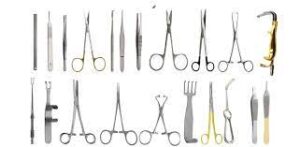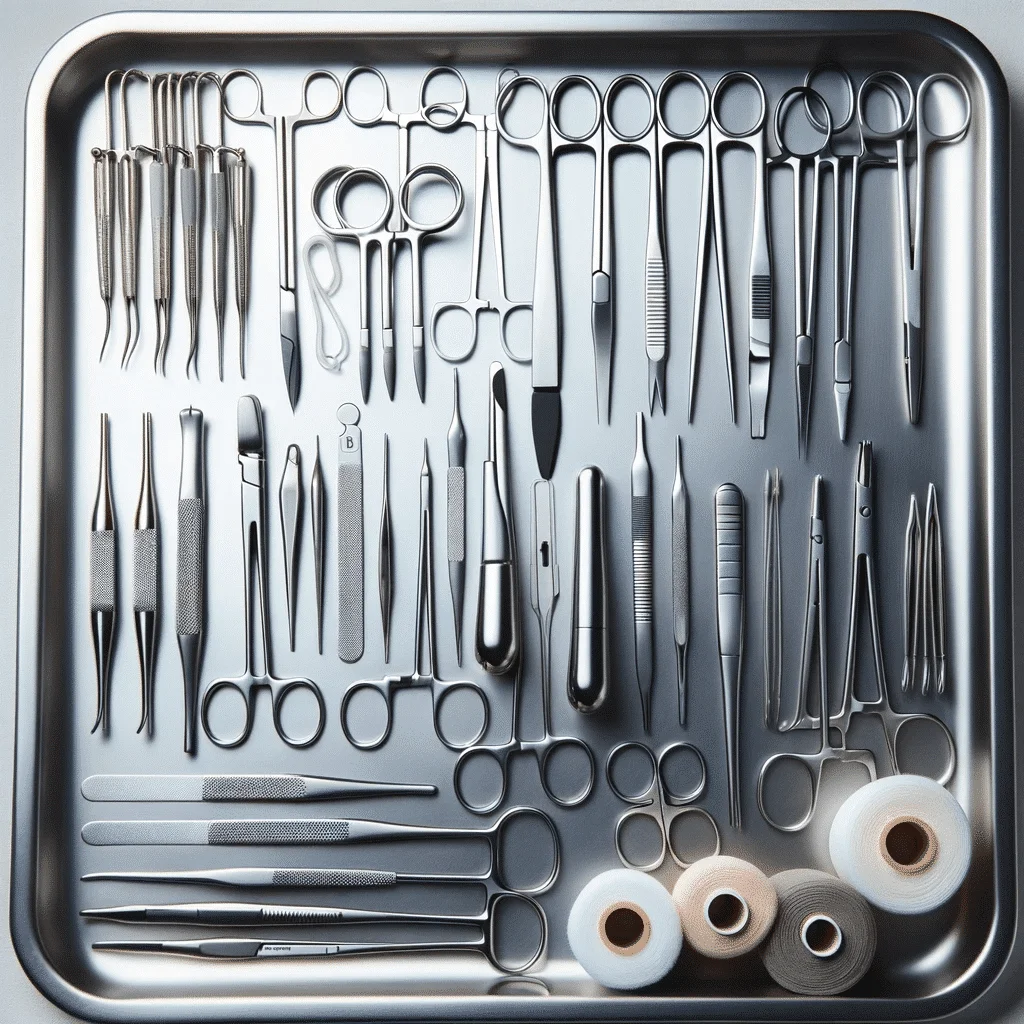Plastic surgery, a field of medicine that focuses on the repair, reconstruction, or alteration of the human body, relies on an extensive array of specialized instruments. These instruments are crucial for ensuring the precision, safety, and effectiveness of surgical procedures. While the instruments used in plastic surgery share similarities with those used in other medical disciplines, they are uniquely designed to cater to the delicate nature of the procedures, which often involve meticulous tissue handling. In this article, we’ll explore plastic surgery instruments in detail, including their classifications, specific uses, and the advancements in their design. Additionally, we will touch upon specialized subsets such as ENT instruments and cosmetic surgery instruments.
Understanding Plastic Surgery Instruments
Plastic surgery encompasses a variety of procedures, ranging from reconstructive surgery to cosmetic enhancements. Each type of surgery requires specific tools to achieve optimal results. Generally, plastic surgery instruments can be categorized into several functional groups:
- Cutting and Dissecting Instruments: These are designed for making incisions, cutting tissues, and dissecting anatomical structures.
- Grasping and Holding Instruments: These are used to manipulate tissues or hold surgical sites open for better access.
- Retracting Instruments: Retractors hold tissues apart to provide a clearer view of the surgical field.
- Suturing Instruments: These tools assist in the closing of incisions with sutures or staples.
- Other Specialized Instruments: These are designed for highly specific functions, such as lasers for tissue ablation or electrosurgical instruments for cutting and coagulating tissues.
1. Cutting and Dissecting Instruments
Cutting and dissecting instruments are integral to the process of plastic surgery, particularly in procedures that involve incisions and the removal of skin or other tissues. Some of the most common instruments in this category include:
– Scalpels: The most recognizable tool in surgery, scalpels are used to make precise incisions. Plastic surgeons often use fine, delicate blades like the No. 15 blade for accurate cuts in cosmetic surgery, minimizing tissue trauma.
– Metzenbaum Scissors: These are delicate, curved scissors used for cutting soft tissues without damaging surrounding structures. They are ideal for dissection in facial surgeries, such as rhinoplasty or facelifts.
– Tenotomy Scissors: These scissors are designed for more precise cutting of tendons and delicate tissue, frequently used in reconstructive procedures.
– Rhinoplasty Saws: These specialized cutting tools are used in nasal surgery to reshape or reposition the nasal bones.
2. Grasping and Holding Instruments
Grasping and holding instruments allow the surgeon to manipulate tissues during the procedure. Precision and control are essential in plastic surgery, and these instruments are designed with that in mind.
– Forceps: Forceps come in various sizes and shapes. Adson forceps, for example, are widely used in plastic surgery to hold skin or delicate tissues. They have fine tips that allow the surgeon to grasp small structures with minimal trauma.
– Needle Holders: These tools are essential for suturing, holding the needle in place as the surgeon makes delicate closures. Castroviejo needle holders are often used for fine suturing in procedures such as blepharoplasty or facelifts.
– Allis Clamps: These instruments hold tissues firmly in place without damaging them, often used in breast surgeries or reconstructive procedures.
3. Retracting Instruments
Surgical retractors are used to hold open incisions or tissues, allowing the surgeon better visibility and access to the surgical area. In plastic surgery, many retractors are small and delicate, designed to work with the precise nature of the procedures.
– Skin Hooks: Small, sharp instruments that retract the skin without causing significant trauma. These are often used in procedures like facial lifts or eyelid surgeries.
– Senn Retractors: These double-ended retractors are commonly used in plastic surgery, with one end designed to retract skin and the other designed for deeper tissues.
– Rhinoplasty Retractors: Specifically designed for nasal surgeries, these tools allow for the controlled retraction of soft tissue during rhinoplasty procedures.
4. Suturing Instruments
Closing incisions with precision is critical in plastic surgery, as visible scarring must be minimized. Suturing instruments in plastic surgery are therefore designed to facilitate fine, precise stitching.
– Skin Staplers: While not commonly used in cosmetic procedures, these are sometimes employed in reconstructive surgery for closing larger wounds.
– Needles and Sutures: Surgeons use specialized needles and sutures designed for plastic surgery to minimize scarring and promote optimal healing. The choice of suture material often depends on the procedure and the location of the incision.
– Tissue Glue: In some cases, instead of traditional sutures, surgeons use tissue glue to close small incisions or reinforce suture lines.
5. Other Specialized Instruments
Plastic surgery, especially cosmetic surgery, often incorporates cutting-edge technologies. Some of these specialized instruments include:
– Laser Devices: Lasers are frequently used in plastic surgery for resurfacing skin, removing blemishes, or performing non-invasive procedures like laser liposuction.
– Electrosurgical Devices: These use electric currents to cut tissue and coagulate blood vessels, reducing bleeding during surgery. Electrosurgical units (ESUs) are commonly used in procedures like facelifts or body contouring.
– Endoscopic Tools: In minimally invasive procedures, such as endoscopic brow lifts, endoscopic instruments allow for smaller incisions and less visible scarring.
ENT Instruments: Precision Tools for Specialized Surgeries
ENT (ear, nose, and throat) instruments are a subset of surgical tools used in procedures involving these specific anatomical regions. While not exclusive to plastic surgery, they are frequently used in facial surgeries, including rhinoplasty, otoplasty, and other reconstructive or cosmetic surgeries involving the head and neck.
Common ENT Instruments Used in Plastic Surgery
– Nasal Speculum: This instrument is used to widen the nostrils, giving the surgeon better access during nasal surgeries like rhinoplasty or septoplasty.
– Freer Elevator: Used to lift and separate tissue, the Freer elevator is an essential tool in nasal reconstruction and other ENT procedures.
– Otolaryngology Forceps: These fine, specialized forceps are designed for the delicate structures of the ear, nose, and throat. For instance, Takahashi forceps are used to grasp nasal tissues.
– Sinus Instruments: For procedures involving the sinuses, such as sinus augmentation in rhinoplasty, specialized instruments like Kerrison Rongeurs are used for removing bone or soft tissue.
ENT instruments are designed with the utmost precision in mind, given the intricate structures involved in the head and neck region. Surgeons who perform cosmetic or reconstructive procedures in these areas rely heavily on these tools.

Cosmetic Surgery Instruments: Tools for Aesthetic Transformation
Cosmetic surgery, a branch of plastic surgery, aims to enhance the patient’s appearance. The instruments used in cosmetic surgery are meticulously designed to achieve aesthetic perfection while minimizing scarring and recovery time. Some of the most commonly used cosmetic surgery instruments include:
Facial Cosmetic Surgery Instruments
For surgeries that involve the face, such as facelifts, brow lifts, and eyelid surgeries, specialized instruments are used to ensure precision:
– Facelift Scissors: These delicate scissors are used to cut through fine tissue layers during rhytidectomy (facelift) procedures.
– Micro Cannulas: These are used in liposuction and fat transfer procedures. The fine size of these cannulas allows for fat removal or injection with minimal trauma to the surrounding tissues.
– Blepharoplasty Clamps: In eyelid surgeries, these clamps help isolate and protect delicate tissues, ensuring precise cutting and suturing.
Breast Augmentation Instruments
Breast augmentation and reconstruction surgeries require instruments that can handle both soft and firmer tissues:
– Breast Retractors: These retractors are specially designed to hold breast tissue out of the way during augmentation or reconstruction surgeries.
– Tumescent Cannulas: These are used to inject fluids into the breast tissues, making the tissue easier to work with and reducing bleeding during procedures.
– Calipers: Precision calipers are used to measure the breasts during surgery to ensure symmetrical results.
Body Contouring Instruments
Body contouring surgeries, such as abdominoplasty (tummy tuck), liposuction, and body lifts, involves removing or reshaping fat and skin. Specific instruments used in these procedures include:
– Liposuction Cannulas: Cannulas are long, thin tubes inserted under the skin to remove fat during liposuction procedures. These come in various sizes, allowing surgeons to target specific areas and achieve the desired contouring.
– Abdominoplasty Retractors: These retractors are used during tummy tucks to hold back the abdominal wall and skin, providing better visibility and access to the surgical site.
– Marking Pens: While seemingly simple, surgical marking pens are crucial in body contouring procedures, ensuring precise guidelines are followed during surgery.
check out more details: fat grafting set
Recent Advancements in Plastic Surgery Instruments
Technological advancements have greatly enhanced the capabilities of plastic surgeons. Minimally invasive techniques have become more common due to innovations in surgical instruments.
– Robotic-Assisted Surgery: Surgeons can now use robotic systems that offer extreme precision, reducing recovery time and minimizing scarring. These systems incorporate tools like micro-cameras and fine-tipped instruments that can be maneuvered with incredible accuracy.
– Laser-Assisted Liposuction: Modern liposuction techniques involve using laser technology, which helps break down fat cells before they are removed, reducing trauma and improving recovery time.
– Endoscopic Techniques: Endoscopic instruments have become widespread in plastic surgery, allowing surgeons to perform complex procedures through tiny incisions. These techniques provide excellent visualization and minimize scarring. Endoscopic tools are used in procedures such as endoscopic brow lifts, where a small camera guides the surgeon, ensuring precision in tissue manipulation.
Training and Maintenance of Plastic Surgery Instruments
Proper training and maintenance of plastic surgery instruments are essential for ensuring their effectiveness and longevity. Surgical teams undergo rigorous training to learn how to use each instrument correctly, as improper use can lead to complications or suboptimal surgical outcomes.
- Training Programs: Many medical schools and surgical residency programs include comprehensive training in the use of surgical instruments. This training covers various instruments’ anatomy, function, and appropriate handling, emphasizing patient safety and optimal outcomes.
- Sterilization and Maintenance: Given the risk of infection and complications, proper sterilization of instruments is critical. Surgical instruments must be cleaned, sterilized, and maintained following strict protocols. This process involves:
– Cleaning: Instruments must be washed to remove blood, tissue, and other debris. Ultrasonic cleaners are often used for thorough cleaning.
– Sterilization: Instruments are typically sterilized using steam autoclaves, ethylene oxide gas, or other methods to eliminate all microorganisms.
– Inspection: Regular inspections are conducted to ensure that instruments are in good condition, free of rust or damage, and functioning correctly.
The Future of Plastic Surgery Instruments
The future of plastic surgery instruments is promising, with ongoing innovations aimed at improving surgical outcomes and patient experiences. Some trends include:
- Smart Instruments: The development of smart surgical instruments equipped with sensors can provide surgeons with real-time feedback, helping them make more informed decisions during surgery. These instruments can monitor parameters such as tissue tension, blood flow, and pressure, enhancing precision.
- 3D Printing: Custom-made instruments and implants can be produced using 3D printing technology, allowing for highly tailored solutions for individual patients. This technology can also produce anatomical models that assist surgeons in planning complex procedures.
- Telemedicine and Remote Surgery: Advances in telemedicine could lead to remote consultations and possibly even remote surgical assistance, where expert surgeons guide less experienced ones through complex procedures using augmented reality or robotic systems.
- Biodegradable Instruments: As sustainability becomes a more pressing concern, the development of biodegradable surgical instruments is on the rise. These instruments can be used for specific procedures and will naturally decompose, reducing medical waste.
Conclusion
Plastic surgery instruments are vital tools that significantly impact surgical outcomes and patient safety. From cutting and dissecting to suturing and grasping, each category of instruments plays a crucial role in ensuring that plastic surgeons can perform their procedures with the utmost precision and care. Additionally, advancements in technology and instrumentation continue to reshape the landscape of plastic surgery, making procedures safer, more efficient, and less invasive.
As we progress, medical professionals must stay informed about the latest developments in surgical instruments and techniques. The use of specialized tools, such as ENT instruments for delicate facial surgeries and cosmetic surgery instruments designed for aesthetic enhancements, underscores the importance of precision and innovation in this field. The continued evolution of plastic surgery instruments will undoubtedly lead to better patient outcomes and a more refined approach to the art and science of plastic surgery.
In summary, understanding the various types of plastic surgery instruments and their applications is crucial for surgeons and patients. Whether you are a medical professional looking to enhance your knowledge or a patient considering plastic surgery, familiarizing yourself with these instruments can help you appreciate the complexity and skill involved in achieving beautiful, functional results.


